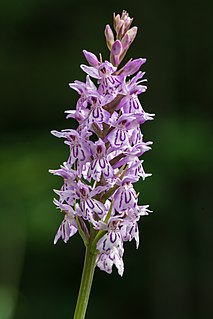
Dactylorhiza fuchsii, the common spotted orchid, is a species of flowering plant in the orchid family Orchidaceae.

Linaria is a genus of 150 species of flowering plants, one of several related groups commonly called toadflax. They are annuals and herbaceous perennials, and the largest genus in the Antirrhineae tribe of the plantain family Plantaginaceae.
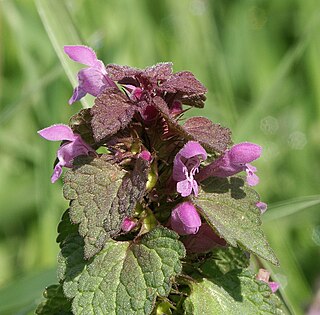
Lamium purpureum, known as red dead-nettle, purple dead-nettle, or purple archangel, is an annual herbaceous flowering plant native to Europe and Asia.
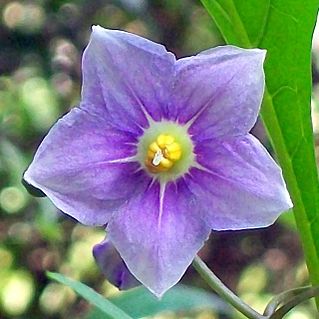
Solanum aviculare, commonly called poroporo, kangaroo apple, pam plum (Australia), or New Zealand nightshade, is a soft-wooded shrub native to New Zealand and the east coast of Australia. Other names used for Solanum aviculare in the Māori language include pōporo, hōreto, and peoi.

Salvia splendens, the scarlet sage, is a tender herbaceous perennial plant native to Brazil, growing at 2,000 to 3,000 m elevation where it is warm year-round and with high humidity. The wild form, rarely seen in cultivation, reaches 1.3 m (4.3 ft) tall. Smaller cultivars are very popular as bedding plants, seen in shopping malls and public gardens all over the world.
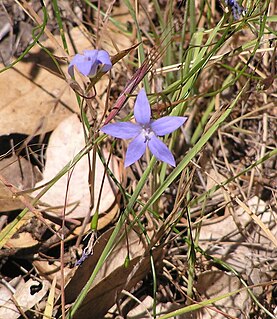
Wahlenbergia is a genus of around 260 species of flowering plants in the family Campanulaceae. Plants in this genus are perennial or annual herbs with simple leaves and blue to purple bell-shaped flowers, usually with five petals lobes. Species of Wahlenbergia are found on all continents except North America, and on some isolated islands, but the greatest diversity occurs in the Southern Hemisphere.

Pinguicula moranensis is a perennial rosette-forming insectivorous herb native to Mexico and Guatemala. A species of butterwort, it forms summer rosettes of flat, succulent leaves up to 10 centimeters (4 in) long, which are covered in mucilaginous (sticky) glands that attract, trap, and digest arthropod prey. Nutrients derived from the prey are used to supplement the nutrient-poor substrate that the plant grows in. In the winter the plant forms a non-carnivorous rosette of small, fleshy leaves that conserves energy while food and moisture supplies are low. Single pink, purple, or violet flowers appear twice a year on upright stalks up to 25 centimeters long.

Banksia columnaris is a species of column-like shrub that is endemic to Western Australia. It has pinnatifid leaves with between five and eighteen lobes on each side, heads of pale yellow to purple flowers and usually only one or two follicles forming in each head.

Banksia stenoprion is a species of prostrate shrub that is endemic to the south-west of Western Australia. It has short, underground stems, pinnatisect leaves with triangular lobes, golden, mauve or purple flowers in heads of up to ninety, and egg-shaped follicles.

Osmanthus heterophyllus, variously known as holly osmanthus, holly olive, and false holly, is a species of flowering plant in the olive family Oleaceae, native to eastern Asia in central and southern Japan and Taiwan.

Stachys sylvatica, commonly known as hedge woundwort, whitespot, or sometimes as hedge nettle, is a perennial herbaceous plant growing to 80 cm (31 in) tall in woodland and unmanaged grassland. In temperate zones of the northern hemisphere it flowers in July and August. The flowers are purple. The leaves, when crushed or bruised, give off an unpleasant fetid smell.
Collinsia linearis is a species of flowering plant in the plantain family known by the common name narrowleaf blue-eyed Mary.
Nemacladus interior is a species of flowering plant in the bellflower family known by the common name Sierra threadplant. It is native to the Sierra Nevada of California, and it is known from Oregon as well. It grows in mountain forest habitat. It is an annual herb producing a stiff upright purple-brown stem up to about 25 centimeters tall. Small toothed oval leaves 1 to 2 centimeters long occur at the base of the plant. The inflorescence is a zigzagging series of branches bearing occasional flowers on thin pedicels. There is a single tiny bract at the base of each pedicel. The flower is a few millimeters long. It has five triangular sepals and five corolla lobes, three lobes on the upper lip and two on the lower. The corolla is white to pale purple or pink with a thin red band and yellow spot at the base of each lobe.

Grevillea rivularis, the Carrington Falls grevillea, is a shrub species which is endemic to New South Wales, Australia.
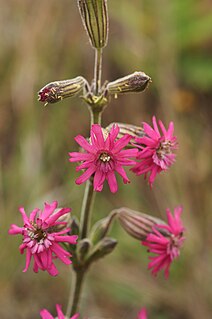
Silene scouleri is a species of flowering plant in the family Caryophyllaceae known by the common names simple campion and Scouler's catchfly.

Veronica anagallis-aquatica is a species of flowering plant in the family Plantaginaceae known by the common names water speedwell, blue water-speedwell,,brook pimpernel, and sessile water-speedwell. It is also listed as Veronica catenata. Its true native range is not clear, but the plant is present on most continents, and in most places it is probably naturalized. It occurs in many types of moist and wet habitat, and it is semi-aquatic, often growing in shallow water along streambanks, in ponds, and in other wetland environments. It is a rhizomatous perennial herb with stems growing 10 centimeters to about a meter in maximum length. It may be decumbent, the stem spreading along the ground and rooting where it touches moist substrate, or erect in form. The oppositely arranged leaves are green, smooth-edged or toothed, and sometimes clasping the stem where the leaf pairs meet at the bases. The inflorescence is a raceme of many flowers arising from the leaf axils. Each flower is borne on a short, curving pedicel. The flower corolla is up to a centimeter wide with four lobes, the upper lobe being widest. It is blue, lavender, or violet with purple lines near the base of each lobe. At the center are two small protruding stamens.
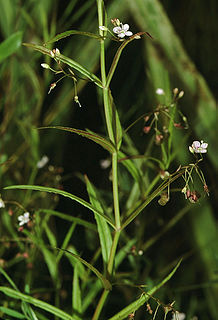
Veronica scutellata is a species of flowering plant in the plantain family known by the common names marsh speedwell, skullcap speedwell, and grassleaf speedwell. It is native to temperate Asia, Europe, northern Africa, and northern North America, including most of Canada and the northern half of the United States. It occurs in moist and wet habitats, such as ponds, marshes and other wetlands. It is a rhizomatous herbaceous perennial producing a decumbent or upright stem 40–60 cm (16–24 in) in maximum height. It is mostly hairless in texture. The purple-green or reddish leaves are oppositely arranged in pairs about the stem, the blades lance-shaped and smooth-edged. The inflorescence is an open array of several flowers on thin, straight pedicels. The flower is up to 1 cm (0.39 in) wide with four lobes, the upper lobe being largest. It is white, blue, or purplish with purple veining. It yields a flat, notched capsule a few millimeters wide.
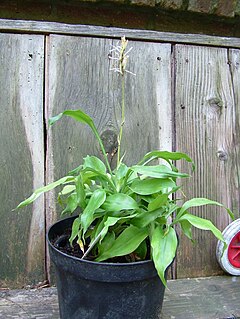
Dracaena braunii is a species of flowering plant in the family Asparagaceae. It was named after the German collector Braun, Johannes M. (1859-1893). Most plants named Dracaena braunii in cultivation are Dracaena sanderiana, a plant with flowers five times longer than those of D. braunii, while the leaf base is not congested as in D. braunii.
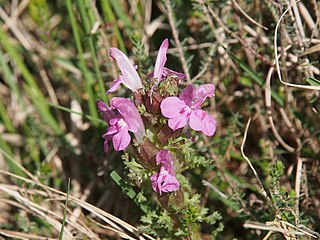
Pedicularis sylvatica, commonly known as common lousewort, is a plant species in the genus Pedicularis. It is native to central and northern Europe where it grows on moist acidic soils, moorland, grassy heathland and the drier parts of marshes.

Isopogon tridens, commonly known as the three-toothed coneflower, is a species of flowering plant in the family Proteaceae and is endemic to the southwest of Western Australia. It is a shrub with wedge-shaped leaves with two or three sharply-pointed teeth, and flattened-spherical heads of glabrous creamy white, sometimes purple flowers.


















